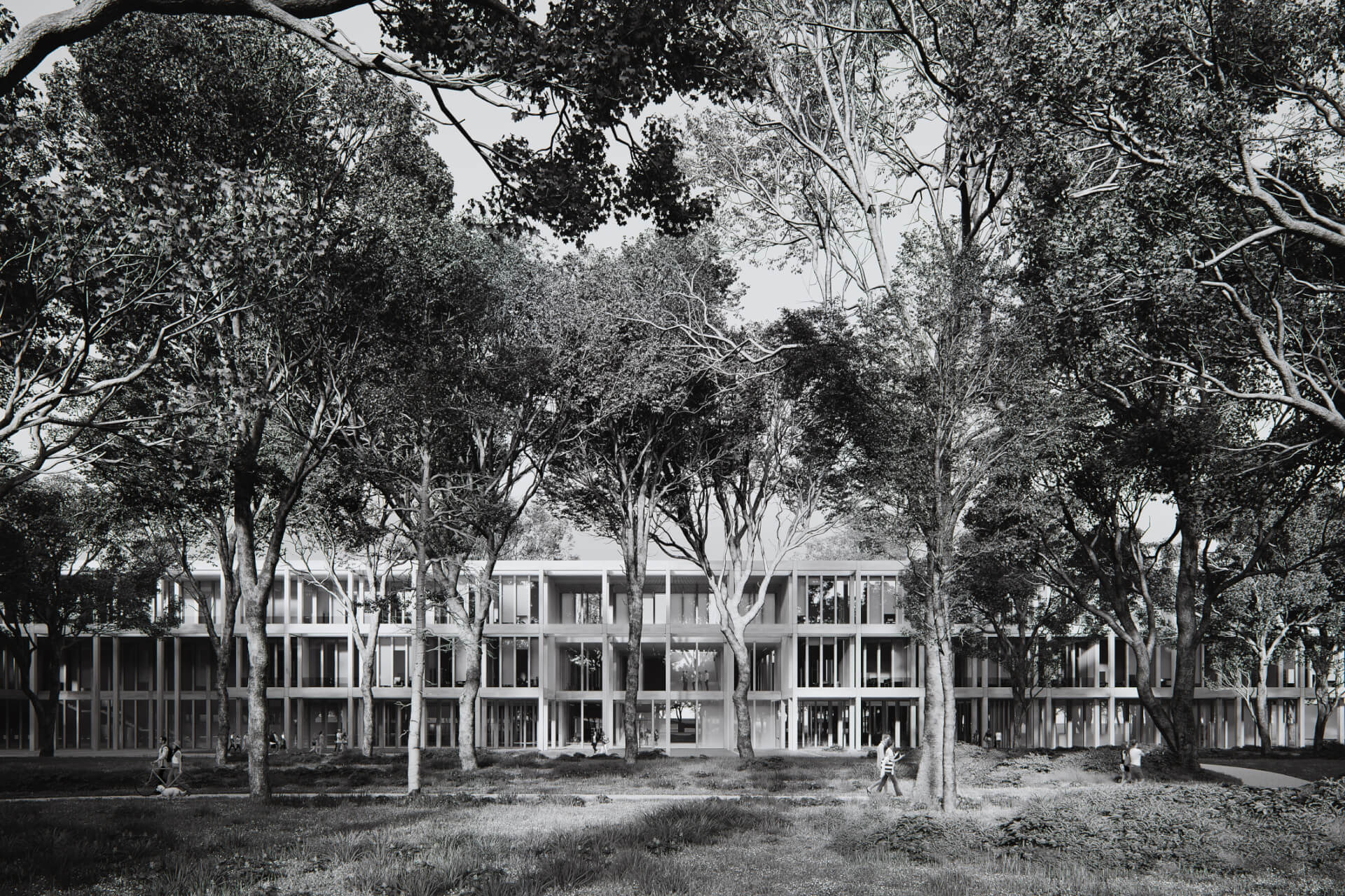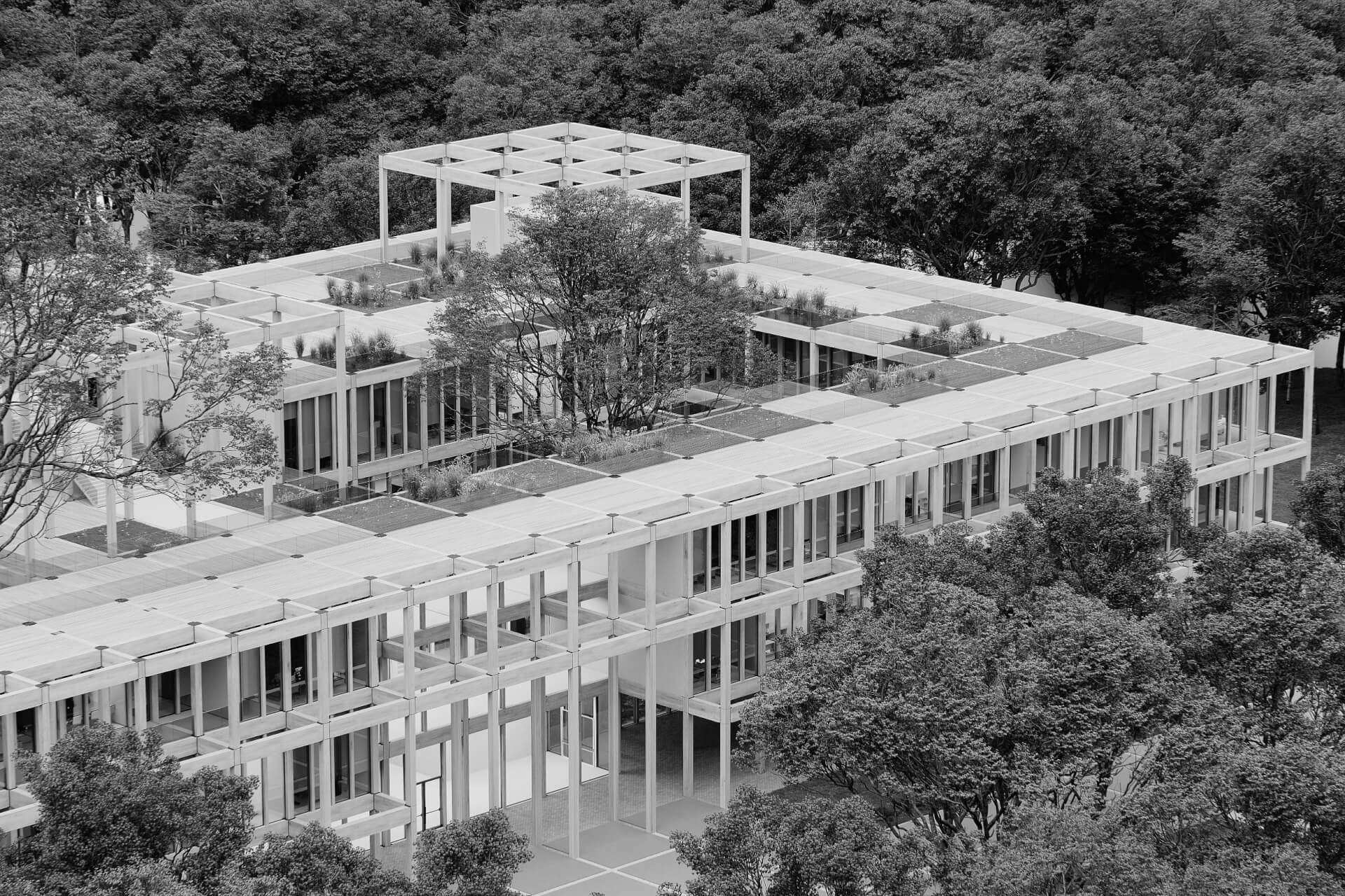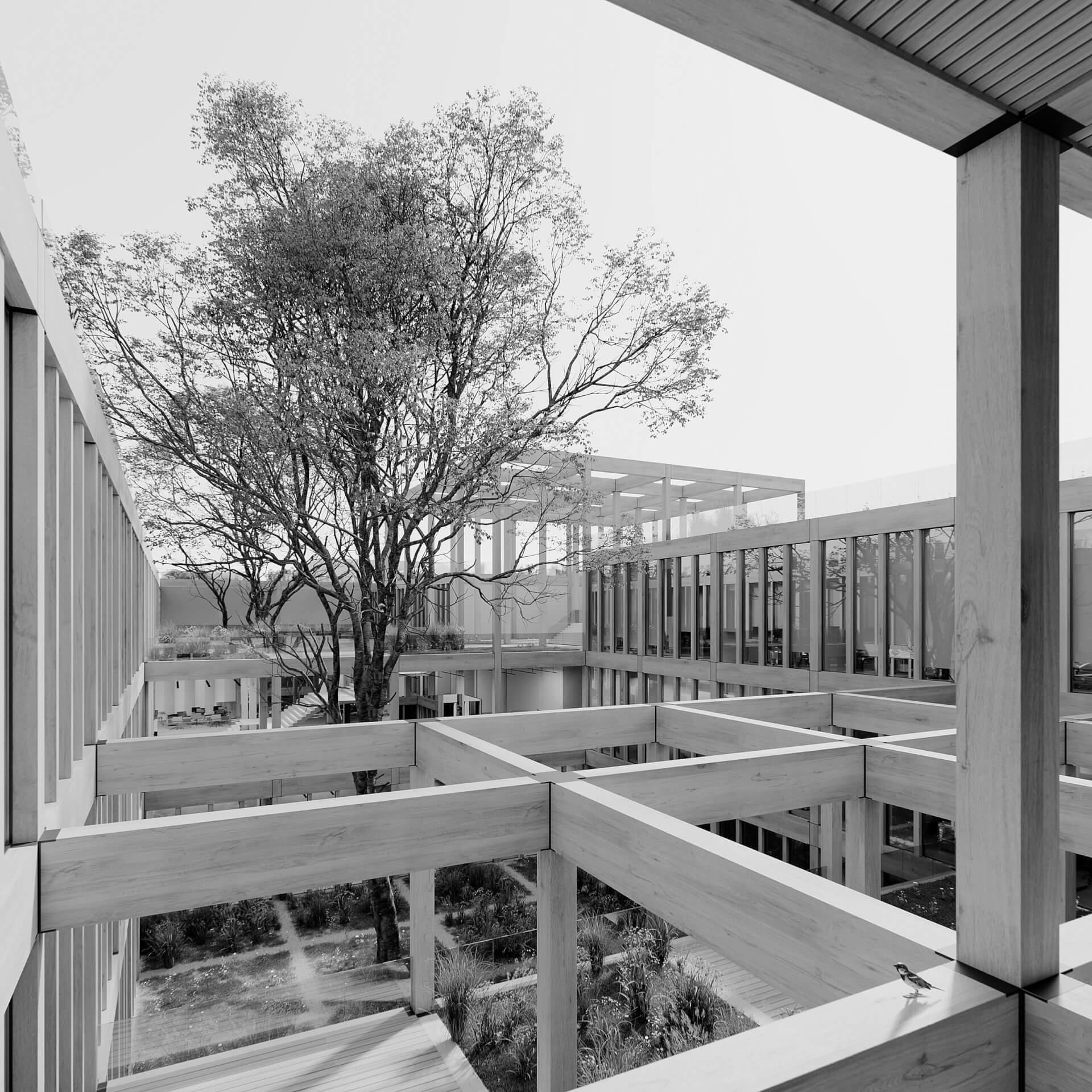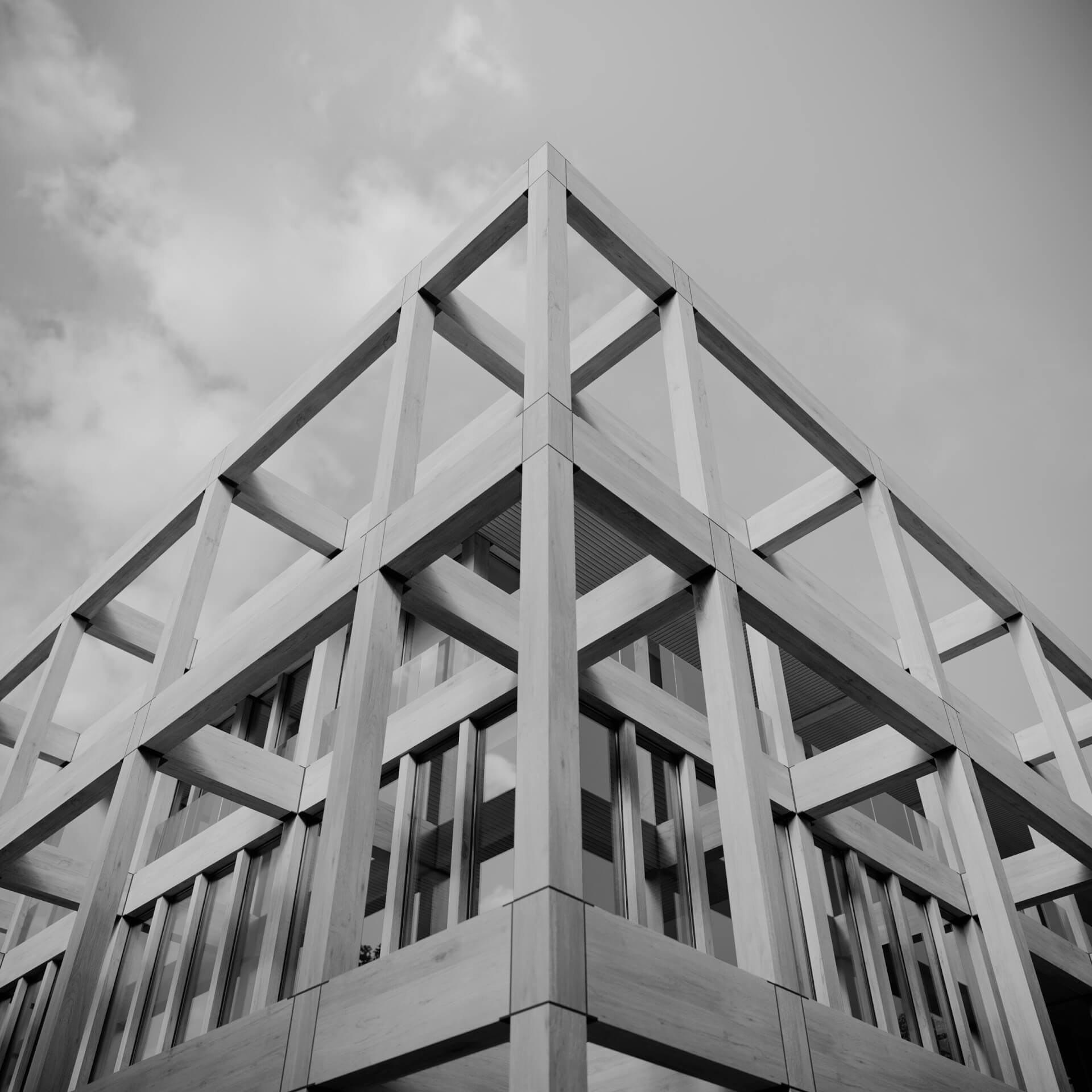music academy
“Pavilion in the park” is a phrase that evokes a multitude of references in the history of architecture. Phillip Johnson once set a clear direction, and his Glass House became the archetype of such designs, although, of course, the history of pavilion designs goes back much further than the mid-20th century. However, it seems that since Johnson’s implementation, almost every architect (from student to professor) secretly nurtures a dream of an ideal object situated amidst nature. The temptation is incredible, every time the environment whispers this sensitive and subtle green direction…
The new location of the Krzysztof Penderecki Music Academy imposes a similar way of thinking to the pavilion project and does not allow ignoring the surroundings of the Grzegórzecki Park, the monuments of nature, the proximity of the Vistula River and the Kurlandzki Boulevard, or finally, the ecological potential of the place. The degraded space of the former barracks already whispers the story of a beautiful English garden with old trees and an unusual object of the Academy that will respectably fit between old trunks and crowns, creating space for academic life and nature.
Contrary to initial ideas, this project does not try to refer to the historical architecture of Krakow (although certain parallels appear), or to the iconic silhouette of the old city looming somewhere in the northwestern views. The idea of the entire project is simply embedded in the park. In this local, still neglected park, although theoretically, the building could be constructed in any garden arrangement, and its disciplined structure would undoubtedly adapt flexibly to any location. In a sense, in terms of context, the object is even introverted. It harmonizes with the nearest surroundings, does not seek an answer to the nearby urban order or its absence. It simply immerses itself in the green, urban oasis near the Vistula. With its discreet presence, it proves that the city can merge with nature in a model way, without squeaks, softly and with respect.
Therefore, the new seat of the Academy has only 3 floors. Most of the trees are higher than it, and all frames or openings always find a human scale. The modular structure of the building is latticed, does not close, on the contrary, it meanders between trees, surrounding two natural monuments with a wide, open space. Over 23-meter-high ash trees tower over the roof of the building, casting life-giving shade on patios, where the smallest dimension is 24m x 24m on the ground floor, and on subsequent floors, this space opens even more inviting to the next level, which is the roof. Hence, between the crowns of trees, you can see the Vistula or the panorama of Krakow.
In the new Academy, you will find an infinite number of unique, intimate frames, places of contemplation, peace, but also spaces pulsing with musical, student life, where interiors and exteriors combine in a gentle symbiosis of nature and civilization.
Construction. One of the most important programmatic decisions of the project is the use of structural timber as the building material. There are two critical aspects to consider here. First, creating a building with the lowest possible carbon footprint is crucial, as energy efficiency or passive construction alone is no longer enough to meet global trends and requirements and minimize the environmental impact of construction in the face of accelerating climate change. Second, the ecological balance of the construction process itself (over 80% of CO2 emissions occur during construction!) and the potential reuse of materials from potential demolition or reconstruction of the building are also significant factors to consider.
The wooden structure, like scaffolding in which only spaces for massive blocks of concert halls and rehearsal rooms have been hollowed out, not only adheres to the standards of rational and ecological architecture but also adds character to the façade and interiors. The cubic structures correspond to the internal functional layout of the building. Some modules are completely integrated into the university’s program, while others leave space in the façade or common areas, creating another corner in which one can hide from the hustle and bustle of the communication paths. The 6m x 6m x 6m structural grid rule is flexibly used as needed. This allows for the organization of space while allowing for a variety of exceptions that humanize the interiors. Importantly, the shared spaces, which are typically large and monumental, will also be punctuated by wooden beams and supports that follow the rhythm of the building’s structure. This will give the concert halls a unique character and make the structure an interior design idea in itself. This “scaffolding” will introduce many moody effects into the interiors, with an interplay of light and shadow with various frames inside the foyer and those facing the park.
The modular structural design, consistent with the spirit of rational architecture, will enable the prefabrication of many elements, reducing construction time, and costs, and achieving a higher standard of the final architectural detail.
Function. The consistent modular structure is also reflected in the functional layout, which was designed with mathematical discipline. The most important factors, such as directions of entry to the concert and university zones, technical support, deliveries, and noise and vibration protection, determined the basic decisions regarding the general functional layout. The goal was to shape space in a clear and straightforward manner for occasional visitors to the Academy of Music as well as for regular users, i.e., students and teachers. This led to significant design decisions regarding the zoning of individual functions.
Concert Zone. Concert halls are public and representative spaces. They are accessible to the audience from the ground floor through the main entrance on Skrzatów street, which is outlined by a cut in the building’s volume and leaving an openwork module construction. This way, approaching the destination, we can see the sky until the last moment, even though we are already partially inside the building, or rather in its openwork arcades. The surrounding arcade will be an important space for the daily functioning of the Academy, like modern cloisters, the “new” Cloth Hall, a public space connecting the entire complex with the park.
The main goal of the musical lobby is to provide very good accessibility to the audience of all concert halls from one common foyer, which is the hub of the entire music zone. It will be a space of the highest rank, strongly linked to the park, but also with a simple formal expression of the architectural means used. Music lovers, largely unfamiliar with the facility, will intuitively “read” this important space. They will spend their last free moments here waiting for the concert and enjoying the views of the urban park with its old trees, which seem to penetrate into the interior. The foyer is intended to tune the audience, calm them down, and finally dissipate the memory of the city’s hustle and bustle, giving the impression of peace and contemplation. The interior dominated by natural wood will be acoustically and visually friendly and merged with the neighboring nature, which will further enhance the mood of peace and readiness for the reception of beautiful classical music.
 all
all 



